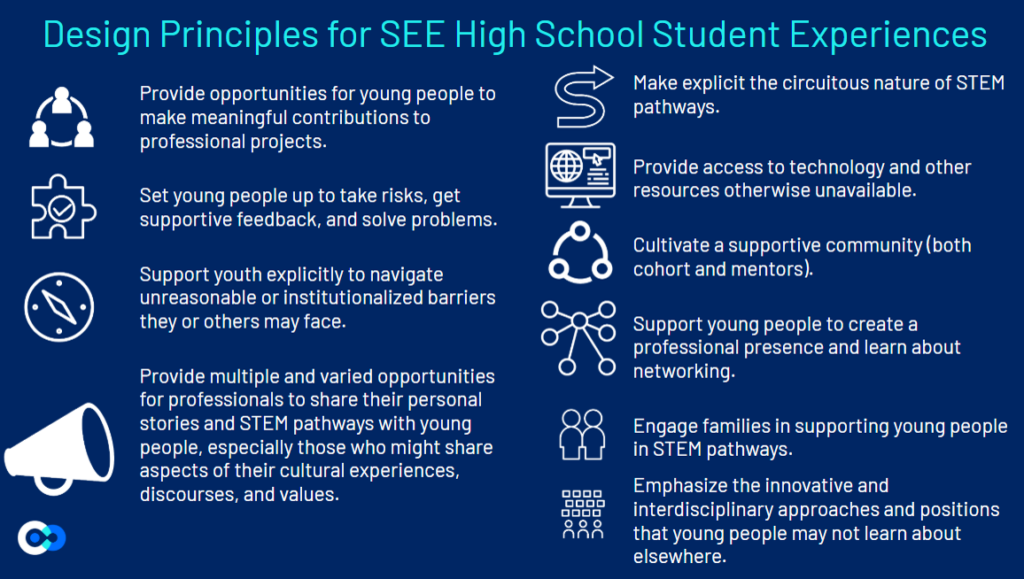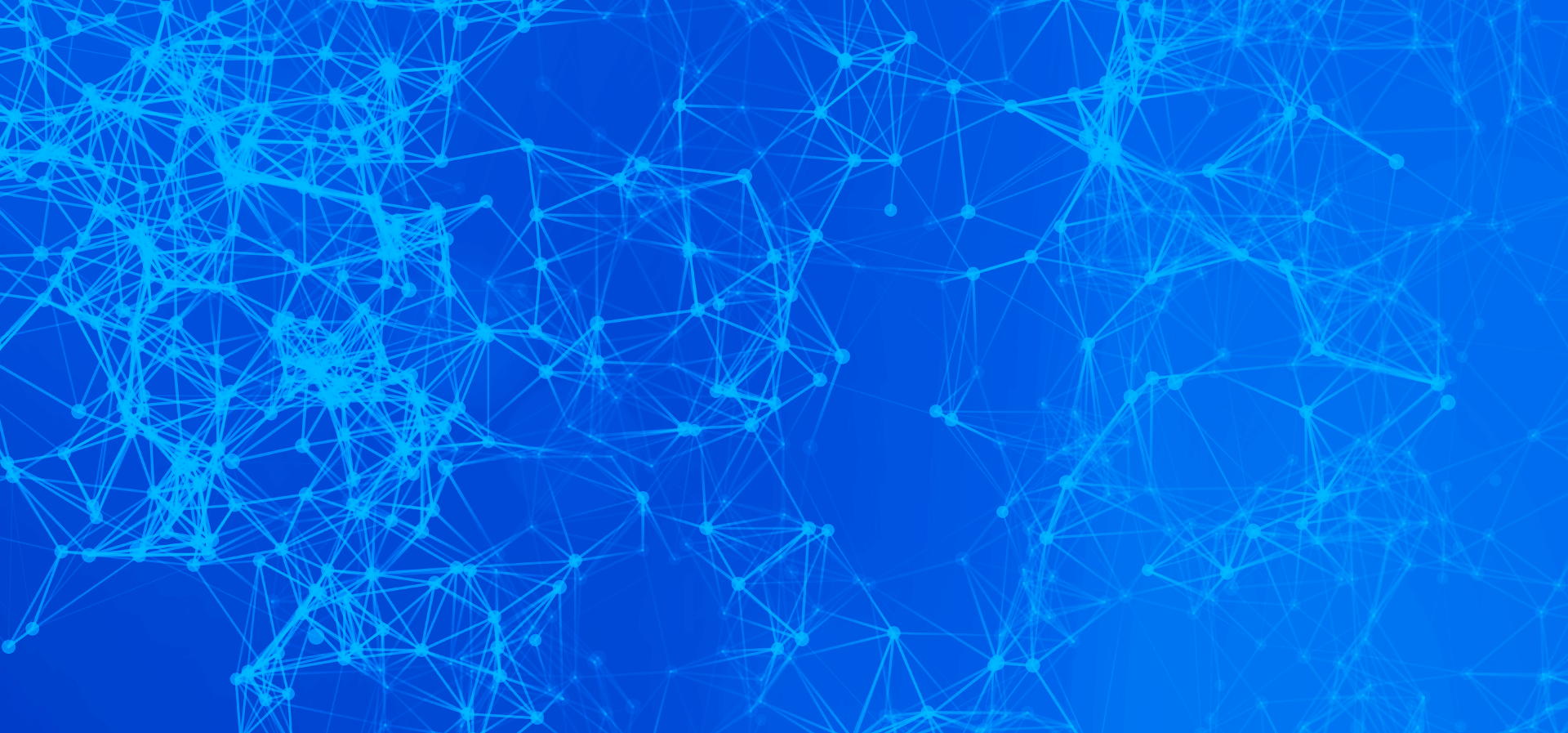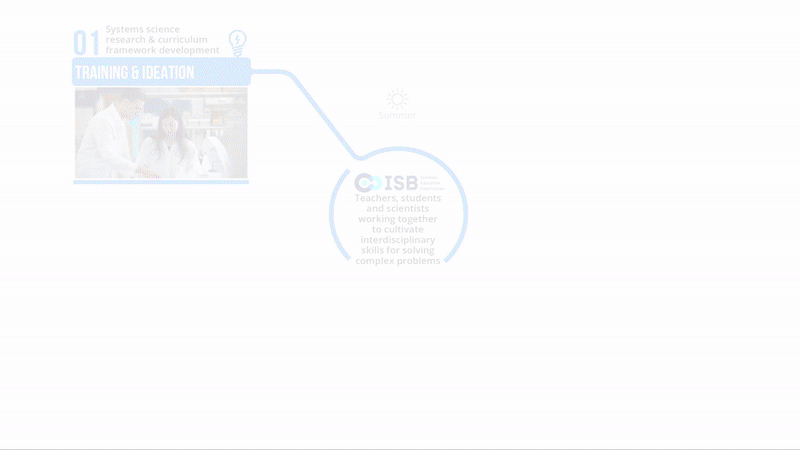Our Vision is for all students to be engaged in using systems-level, scientific thinking to better understand and participate in solving today’s complex problems.
Our Purpose is, therefore, to cultivate interdisciplinary skills for solving complex problems.
We recognized that some schools and populations of students have better access to authentic STEM (science, technology, engineering and math) experiences than others. We want to make quality STEM education a reality for every student regardless of race, gender or socioeconomic status. Thus our program model integrates the voices and expertise of all stakeholders. We work directly with students and teachers to build and implement engaging experiences both at ISB and for classrooms across the world. It is our hope that ultimately, every person will be able to learn, live, work and engage in solving complex systems problems. For more information on the SEE program model, please watch this video and read more below.
01 Training and Ideation
Our iterative program begins with a cross-disciplinary, hands-on summer internship. Teachers and students (high school through graduate) work with STEM scientists during the summer to learn how systems science is applied to better understand and solve today’s complex problems. They do this by completing authentic research together. As they collaboratively work through their research project, they ideate on the specific practices, skills, and concepts being used to understand and progress through that project. They cross-check those practices, skills and disciplinary core ideas/concepts against what is currently available for schools. If a gap and need are identified, then the team begins the process of translating that systems research into a curriculum module. This curriculum development process results in the building of a storyline, lessons, teaching aids, suggested materials, protocols, and technology – all are based on what they learned in the lab and on current educational standards and best practice. All modules are aimed at helping students develop the thinking and concepts required for using systems science to solve complex problems. This results in an interdisciplinary, hands-on experience for students.
02 Classroom Pilots
During the academic year, these curricular ideas, frameworks, lessons and materials are field-tested in classrooms (generally in 8-12th grades). Since the module is interdisciplinary, it is field-tested in a variety of courses. In traditional non-integrated courses, such as Biology or Chemistry, the module is presented with a key problem or phenomenon at the center. Since that problem or phenomenon is based on systems biology, it inherently brings together biology, chemistry, physics, engineering, mathematics, statistics, and computer science. Within a specific course, certain concepts may be emphasized in one course, such as Biology, whereas other chemical concepts would be more deeply covered in a chemistry course. Data and information are gathered and analyzed during field tests by teachers and the SEE team.
03 Curriculum Optimization
During the summer, that feedback is brought back to a new, slightly modified summer team to further optimize the curriculum module while connecting more completely to best education practices, standards, and the systems-level work being completed in the lab. Field-testing, modification, and optimization generally occur over three years. If hands-on cultures and lab materials are needed to enable easy classroom implementation, then a kit of materials is designed and made available. Most often, we design lab protocols with general materials and equipment found in local stores. Our goal is for all schools, especially those who are underserved, to be able to easily access and implement these modules.
04 Dissemination and Support
All curricular materials, online tools, and teaching aids are placed on our website for broad dissemination. The modules generally focus on the new systems process of science. Because this is often a paradigm shift for educators, the SEE team attends and hosts professional development institutes to train teachers to bring these hands-on STEM experiences to their students. New ideas come from teachers at those institutes and the cycle begins again!
Scaling Up Student Experiences

The curriculum modules created through this process bring authentic science to classrooms. The content of the modules includes hands-on skills that interns learn while at ISB. In an effort to scale up high school student internships and the Training and Ideation step of the SEE model, we have created ambassadorships and courses. All high school student experiences are guided by ten design principles. These principles are further divided into 5 main goals for all high school programming and resources. This includes both our direct work with students and also the indirect work through teachers using our curriculum modules. These goals are to:
- LEARN about systems,
- DEVELOP professional skills,
- EXPLORE new topics,
- COLLABORATE on team projects and
- NETWORK socially and professionally.
The intended outcomes of all of our Experiences are to build on students’ STEM interest, proficiency, and 21st Century Skills and to support deeper learning and participation in STEM. This includes improving STEM identity, confidence, and social capital. Please see our Impact and our Students pages for more information.
Please view this video for more information on SEE which was developed as part of a National Science Foundation STEM Showcase. This work is made possible by the National Science Foundation primarily, but also by many others including the National Institutes of Health, family foundations, corporations, and individual donors. Please see our Partners webpage for more information. Please also see our Curriculum Modules and Curriculum Development pages for more information on both the SEE model and the resources produced.



